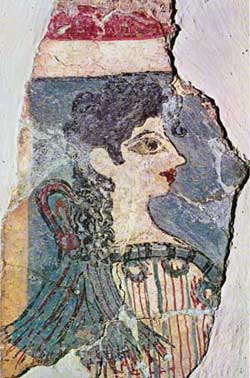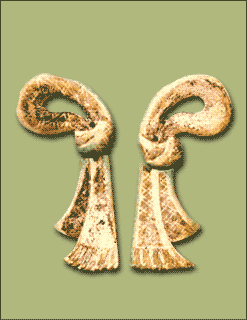The "sacral knot" is a loop of cloth with two fringed ends hanging down, and it occurs quite often in Minoan and Mycenaean art. In some paintings, like this one from Knossos, people wear these knots attached to the back of their clothes.
 |
| Image found here. |
It was Arthur Evans who coined the term "sacral knot". I don't like the term and I think Evans tended to let his romantic sensibilities run away with him. The knot certainly had cultural and possibly ritual significance, but we don't know exactly what it signified. It may have been a kind of protective amulet, similar to the Egyptian tyet hieroglyph.
Anyway, the knotted scarf has a very long history in the Aegean. When the knot occurs in paintings, it's coloured blue and red*. It usually has a reticulated pattern with blue and red fringes, which confirms that there are two warp colours involved.
 |
| Faience "sacral knots" from Grave Circle A at Mycenae. Picture found here. |
Working out how to finish the ends was a bit of a problem for me. The warp threads are allowed to hang loose on these knots, and don't appear to have been knotted together to prevent unraveling. So how should I stop the ends unraveling? And what about the coloured stripes at each end? Those could be supplementary weft threads, but that doesn't explain how to finish the ends. So I've taken a bit of an educated guess and twined red yarn around the warp threads.** I should stress this is totally conjectural. It stops the fabric unraveling and replicates the coloured stripe at the ends of the Mycenaean knot, but beyond that there's no support for this method. This is another one for the "you can't prove it's wrong" file.
The Challenge: Re-do. I'm repeating Challenge 10: Art, but also Challenge 13: Under $10 and Challenge 2: Innovation, which is cool because I didn't manage to do Innovation the first time round and that really bummed me out. Using supplementary yarns to create patterned textiles was a very early innovation, but one of the most important innovations in the history of Bronze Age Aegean textile manufacture.
Fabric: Relatively balanced tabby weave woolen cloth with a supplementary warp pattern.
Pattern: I drafted it myself based on Minoan and Mycenaean art.
Year: Anywhere from 1700 to 1050 BCE.
Notions: N/A.
How historically accurate is it? Well, I know the colours are about right, but this wool will have been dyed with synthetic dyes and while wool is probably the right fiber, Bronze Age wool was structurally different to the merino wool available in my local shop.
I have tried to construct the fabric in as accurate a way as possible, based on what we know about Bronze Age Aegean textile production, but as I said my method of binding the ends is conjectural. All up, I'd guess maybe 8/10 for accuracy.
Hours to complete: Somewhere around 5 hours.
First worn: Yesterday to Classics Department movie night.
Total cost: $9.90.
*Crowley, J. L. 2012 ‘Prestige Clothing in the Bronze Age Aegean’ in Kosmos pp 231-239.
**The stripes on the ends of the Mycenaean bands are clearly stripes of contrasting colour. You could do that with a weft faced weave, but many depictions of sacral knots predate the use of weft faced weaving in the Aegean (see Smith, J. 2012 ‘Tapestries in the Mediterranean Late Bronze Age’ in Kosmos, pp 241-248). Weft faced cloth only shows up at the end of the Bronze Age, probably for the simple reason that it's very, very hard to achieve on a warp weighted loom. It might be doable using linen warp, wool weft and very heavy weights, but tapestry looms would be a better choice. In later periods weft-faced cloth was made on tapestry looms.

No comments:
Post a Comment